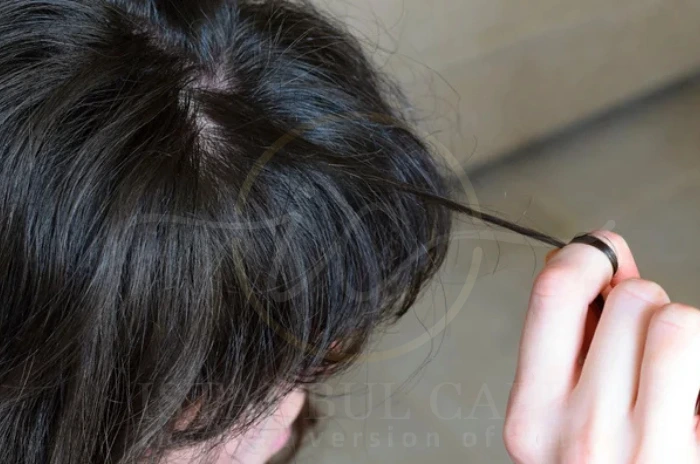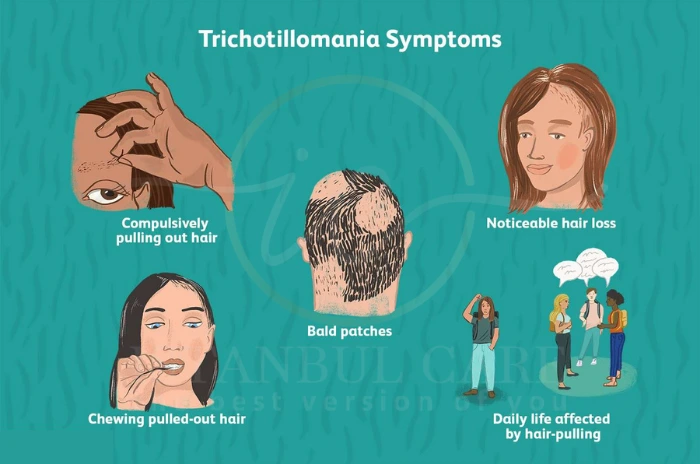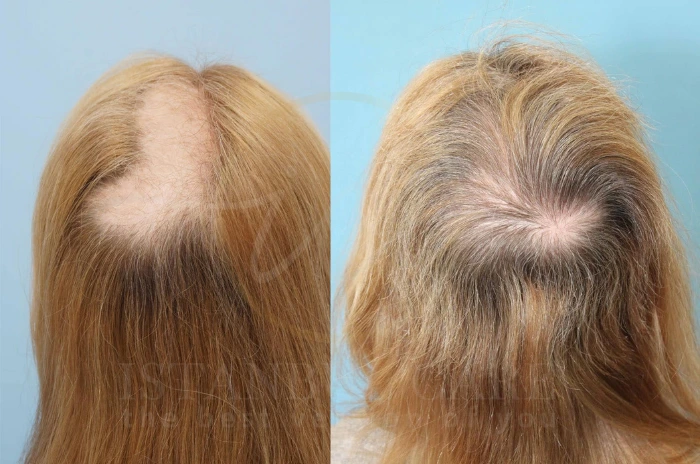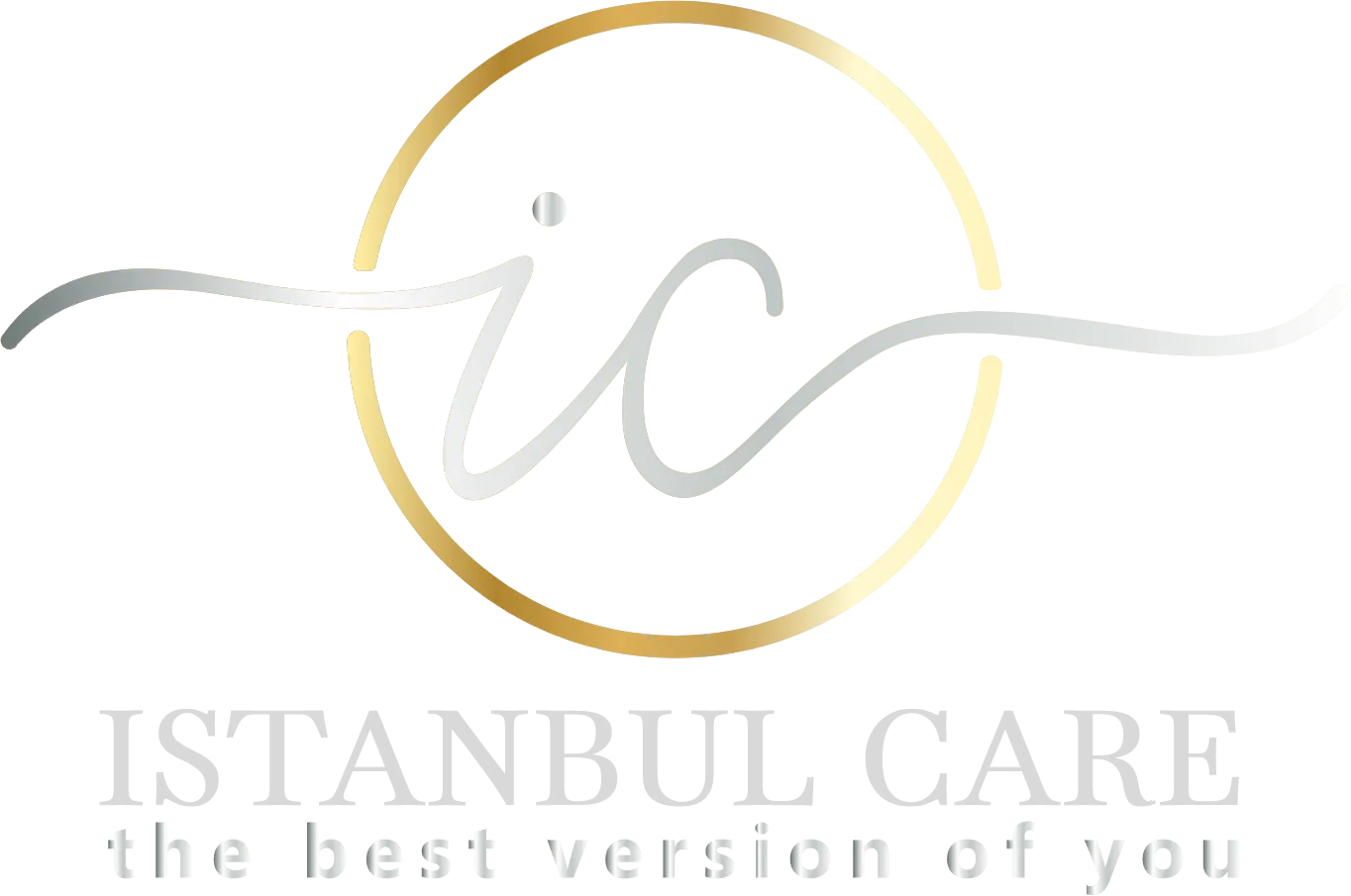Hair pulling disorder, also known as trichotillomania, is a complex mental health condition that affects millions of people worldwide. This compulsive hair pulling behavior goes far beyond occasional tugging or playing with hair. It’s a serious condition that can lead to significant hair loss, emotional distress, and social challenges.
Understanding trichotillomania is crucial for those experiencing symptoms of trichotillomania and their loved ones. This disorder involves repeated urges to pull out hair from various parts of the body, most commonly from the scalp, eyebrows, or eyelashes. The resulting hair loss from pulling can create bald spots and cause considerable psychological distress.
Mental health and hair pulling are closely connected, as this disorder often develops alongside anxiety, depression, or other mental health conditions. The good news is that effective trichotillomania treatment options are available, including specialized therapy approaches and supportive interventions that can help individuals regain control over their pulling out behaviors.

What Is Hair Pulling Disorder (Trichotillomania)?
Trichotillomania is classified as a body-focused repetitive behavior (BFRB) and falls under the category of obsessive-compulsive and related disorders in mental health diagnostics. People with this condition experience recurrent urges to pull out their hair, which they may find difficult or impossible to resist. The hair pulling disorder typically begins during adolescence but can start at any age.
The name trichotillomania comes from Greek words meaning “hair,” “pull,” and “madness.” However, this compulsive hair pulling condition is not a sign of madness but rather a legitimate mental health disorder that requires understanding and appropriate treatment. Individuals with trichotillomania often feel shame and embarrassment about their behavior, which can delay seeking help.
Common signs and symptoms of trichotillomania
The primary symptom is the repeated pulling out of hair, resulting in noticeable hair loss. People with this condition may pull hair from their scalp, eyebrows, eyelashes, beard, or other body areas. The hair pulling symptoms often include feelings of tension before pulling and relief or pleasure during the act.
Many individuals with trichotillomania also engage in rituals around their hair pulling, such as examining the hair root, playing with the pulled hair, or even eating it (which can lead to trichobezoar formation). The behavior typically occurs during periods of relaxation, concentration, or stress, and individuals may not always be fully aware they’re doing it.
Who is affected by hair pulling disorder?
Trichotillomania affects approximately 1-2% of the population, with onset typically occurring during early adolescence. The condition is more common in females than males, with a ratio of approximately 9:1 in adults. However, trichotillomania in children shows a more equal gender distribution.
The disorder can affect people from all backgrounds and socioeconomic levels. Family history of trichotillomania or other body-focused repetitive behaviors may increase the risk of developing the condition. Many people with trichotillomania also experience other mental health conditions such as anxiety, depression, or obsessive-compulsive disorder.
Main Symptoms of Trichotillomania
The symptoms of trichotillomania extend beyond the physical act of hair pulling. This complex disorder involves both behavioral and emotional components that can significantly impact a person’s daily life and well-being.
Individuals with compulsive hair pulling often experience a buildup of tension or urge before pulling, followed by a sense of relief or gratification during the act. This cycle reinforces the behavior and makes it increasingly difficult to stop without proper intervention and trichotillomania treatment.
Signs to Look Out For
Key hair pulling symptoms include noticeable hair loss from pulling hair that creates bald spots or areas of significantly thinned hair. The hair loss pattern is typically irregular and doesn’t follow natural hair loss patterns seen in medical conditions like alopecia.
Other observable signs include shortened or broken hair in affected areas, repeated touching or tugging at hair throughout the day, and attempts to hide hair loss bald spots with hairstyles, hats, or makeup. Many individuals also show signs of hair pulling anxiety and may avoid situations where their hair loss might be noticed.
Emotional and Physical Effects
Emotional hair pulling often occurs during periods of stress, boredom, anxiety, or intense concentration. The physical effects include not only hair loss from pulling but also potential skin irritation, infections, or scarring in severe cases.
The emotional impact can be profound, including feelings of shame, embarrassment, and social isolation. Many people with trichotillomania report decreased self-esteem and may avoid social activities or intimate relationships due to concerns about their appearance.
Causes of Trichotillomania
Understanding the causes of hair pulling is essential for developing effective treatment approaches. Trichotillomania is believed to result from a complex interaction of genetic, psychological, and environmental factors rather than a single cause.
Research suggests that compulsive hair pulling causes may include neurobiological differences in brain structure and function, particularly in areas related to impulse control and habit formation. These differences may create a predisposition to developing body-focused repetitive behaviors like trichotillomania.
Psychological factors linked to hair pulling
Mental health and hair pulling are closely interconnected. Many individuals with trichotillomania have co-occurring mental health conditions such as anxiety disorders, depression, or obsessive-compulsive disorder. These conditions may contribute to the development or maintenance of hair pulling behaviors.
Perfectionism, low self-esteem, and difficulty managing emotions are also common psychological factors. Some individuals use hair pulling as a coping mechanism for managing overwhelming feelings or as a way to achieve a sense of control during stressful periods.
How stress and anxiety trigger trichotillomania
Hair pulling stress and hair pulling anxiety often serve as significant triggers for trichotillomania episodes. Stressful life events, academic pressure, relationship problems, or major life changes can increase the frequency and intensity of hair pulling behaviors.
The relationship between stress and trichotillomania often becomes cyclical, where stress triggers hair pulling, which then creates additional stress about appearance and self-control, leading to more hair pulling. Breaking this cycle is a crucial component of effective trichotillomania treatment.
Common Types of Hair Pulling
Trichotillomania manifests in different ways, and understanding these variations is important for developing appropriate trichotillomania therapy approaches. Mental health professionals typically identify two main types of hair pulling based on the level of awareness during the behavior.
These different types of compulsive hair pulling may require different therapeutic approaches and strategies. Some individuals experience only one type, while others may alternate between both depending on circumstances and emotional states.
Focused Hair Pulling
Focused hair pulling occurs when individuals are fully aware of their actions and make deliberate decisions to pull hair. This type often involves specific rituals, such as searching for particular types of hairs or examining the hair root after pulling.
People experiencing focused hair pulling may spend considerable time looking for the “right” hair to pull and may feel a sense of satisfaction or completion when they find and remove it. This type is often more difficult to interrupt because of the intentional nature of the behavior.
Automatic Hair Pulling
Automatic hair pulling happens without conscious awareness, often during activities like reading, watching television, or talking on the phone. Individuals may not realize they’re pulling out hair until they notice the hair in their hands or see the resulting hair loss.
This type of trichotillomania can be particularly frustrating because people feel they have no control over the behavior. However, it often responds well to awareness training and environmental modifications as part of comprehensive trichotillomania treatment.

Complications of Trichotillomania
Trichotillomania can lead to various complications that affect both physical health and emotional well-being. Understanding these potential complications emphasizes the importance of seeking appropriate trichotillomania treatment and support.
The severity of complications often correlates with the duration and intensity of the hair pulling behavior. Early intervention and proper treatment can help prevent or minimize these complications while improving overall quality of life.
How hair pulling affects physical health
The most obvious physical complication is hair loss from pulling hair, which can range from small bald spots to extensive areas of missing hair. Repeated hair pulling can damage hair follicles, potentially leading to permanent hair loss in severely affected areas.
Other physical complications may include skin irritation, infections from damaged skin, and in rare cases, trichobezoar formation when pulled hair is ingested. Trichobezoar refers to hairballs that can form in the stomach and may require medical intervention if they become large enough to cause blockages.
The emotional complications of trichotillomania can be just as significant as the physical ones. Many individuals experience intense shame, embarrassment, and guilt about their hair pulling behavior, which can lead to social isolation and avoidance of activities.
Mental health and hair pulling complications often include decreased self-esteem, anxiety about appearance, and depression. These emotional impacts can create a cycle where negative emotions trigger more hair pulling, which then generates additional emotional distress.
Diagnosing Trichotillomania
Proper diagnosis of trichotillomania is essential for accessing appropriate treatment and support. The diagnostic process involves a comprehensive evaluation by a qualified mental health professional who specializes in body-focused repetitive behaviors or related conditions.
Hair pulling disorder diagnosis is based on specific criteria that help distinguish it from other conditions that might cause hair loss or repetitive behaviors. Understanding the diagnostic process can help individuals and families know what to expect when seeking professional help.
When to seek help for hair pulling disorder
Professional help should be sought when hair pulling begins to interfere with daily life, causes significant distress, or results in noticeable hair loss. Many people wait years before seeking help due to shame or embarrassment about their trichotillomania symptoms.
Early intervention is beneficial for trichotillomania outcomes. Signs that indicate the need for professional help include spending significant time pulling out hair, creating bald spots, avoiding social situations due to appearance concerns, or experiencing intense urges that feel impossible to control.
How doctors diagnose trichotillomania
Mental health professionals use specific diagnostic criteria to identify trichotillomania. The diagnosis requires evidence of recurrent hair pulling resulting in hair loss, repeated attempts to decrease or stop the behavior, and significant distress or impairment in functioning.
The diagnostic process typically includes a detailed clinical interview, assessment of symptoms of trichotillomania, and sometimes questionnaires or rating scales. Healthcare providers will also rule out medical conditions that could cause hair loss and assess for co-occurring mental health conditions.
Who Is at Risk for Trichotillomania?
Understanding risk factors for trichotillomania can help with early identification and intervention. While anyone can develop this hair pulling disorder, certain factors may increase the likelihood of developing the condition.
Risk factors don’t guarantee that someone will develop trichotillomania, but awareness of these factors can promote earlier recognition of symptoms of trichotillomania and prompt appropriate help-seeking behaviors.
Age and Gender Factors
Trichotillomania in children often begins between ages 9-13, with peak onset during early adolescence. The condition can also develop in early childhood or adulthood, though adolescent onset is most common.
Gender differences are notable, with females being significantly more likely to develop trichotillomania than males, particularly in adolescence and adulthood. However, trichotillomania in children shows more equal gender distribution, suggesting that social and hormonal factors may influence gender differences in older populations.
Family History and Co-Existing Conditions
Family history of trichotillomania or other body-focused repetitive behaviors increases risk for developing the condition. Genetic factors appear to play a role, though the exact inheritance patterns are not fully understood.
Co-existing mental health conditions such as anxiety disorders, depression, obsessive-compulsive disorder, and attention-deficit/hyperactivity disorder are common in individuals with trichotillomania. Having these conditions may increase the risk of developing compulsive hair pulling or may complicate treatment approaches.

Trichotillomania Treatment and Support
Effective trichotillomania treatment involves a comprehensive approach that addresses both the behavioral aspects of hair pulling and any underlying emotional or psychological factors. Treatment options have evolved significantly, and many individuals can achieve substantial improvement with appropriate interventions.
The most successful trichotillomania therapy approaches often combine behavioral techniques with supportive therapy and, when appropriate, medication. Treatment should be tailored to each individual’s specific needs, symptoms, and circumstances.
Therapy options for compulsive hair pulling
Habit reversal training (HRT) is considered the gold standard for trichotillomania treatment. This behavioral therapy helps individuals become more aware of their hair pulling triggers and develop alternative behaviors to replace the pulling out response.
Cognitive-behavioral therapy (CBT) is another effective approach that addresses the thoughts, feelings, and behaviors associated with trichotillomania. Acceptance and commitment therapy (ACT) focuses on accepting urges without acting on them while pursuing meaningful life goals despite the presence of hair pulling urges.
| Treatment Type | Primary Focus | Duration | Effectiveness |
|---|---|---|---|
| Habit Reversal Training (HRT) | Awareness and competing responses | 8-12 weeks | High effectiveness for trichotillomania |
| Cognitive Behavioral Therapy | Thoughts, feelings, behaviors | 12-16 weeks | Moderate to high effectiveness |
| Acceptance Commitment Therapy | Accepting urges, values-based living | 8-12 weeks | Moderate effectiveness |
| Medication (SSRIs) | Brain chemistry regulation | Ongoing | Variable effectiveness |
| N-Acetylcysteine (NAC) | Glutamate system regulation | 12+ weeks | Promising results for hair pulling |
Self-help strategies to manage trichotillomania
Self-help strategies can be valuable complements to professional trichotillomania therapy. Environmental modifications, such as keeping nails short, wearing gloves, or using fidget tools, can help reduce automatic hair pulling.
Stress management techniques, including relaxation exercises, mindfulness meditation, and regular physical activity, can help address hair pulling stress and hair pulling anxiety. Identifying and avoiding personal triggers while developing healthy coping mechanisms is also crucial for long-term success.
Where to find support for hair pulling disorder
Support can be found through mental health professionals specializing in body-focused repetitive behaviors, support groups for trichotillomania, and online communities. The TLC Foundation for Body-Focused Repetitive Behaviors is an excellent resource for information and support.
Many people benefit from connecting with others who understand the challenges of living with trichotillomania. Peer support can reduce feelings of isolation and provide practical strategies for managing the disorder.
How Is Hair Pulling Disorder Treated?
Professional trichotillomania treatment typically involves evidence-based therapies that have been shown to be effective for body-focused repetitive behaviors. Treatment approaches are often individualized based on the person’s age, severity of symptoms, and co-occurring conditions.
The treatment process usually begins with a thorough assessment to understand the specific patterns, triggers, and functions of the hair pulling behavior. This information guides the development of a personalized treatment plan.
Behaviour Therapy and Habit Reversal
Habit reversal training (HRT) remains the most widely used and effective behavioral treatment for trichotillomania. This approach includes awareness training to help individuals recognize when they’re about to engage in hair pulling, competing response training to develop alternative behaviors, and motivation techniques.
The competing responses taught in HRT are behaviors that are incompatible with hair pulling, such as clenching fists, sitting on hands, or engaging in fidget activities. These alternative behaviors help break the automatic pulling out response while the urge passes.
Medications (SSRIs, Antipsychotics, NAC)
While no medications are specifically approved for trichotillomania, several have shown promise in clinical trials and practice. Selective serotonin reuptake inhibitors (SSRIs) may be helpful, particularly when anxiety or depression co-occur with hair pulling.
N-acetylcysteine (NAC), a supplement that affects glutamate regulation in the brain, has shown effectiveness in some studies for reducing trichotillomania symptoms. Certain antipsychotic medications have also been used with some success, though they’re typically reserved for more severe cases.
Living With Trichotillomania
Successfully living with trichotillomania involves developing effective coping strategies, building a strong support system, and maintaining hope for recovery. Many individuals with this hair pulling disorder lead fulfilling lives while managing their symptoms.
The journey of living with trichotillomania often involves periods of improvement and setbacks. Understanding that recovery is typically not linear can help individuals maintain motivation and continue working toward their goals.
Coping Strategies and Daily Habits
Developing daily habits that support recovery is crucial for long-term success. This might include regular stress management practices, maintaining awareness of triggers, and consistently using learned coping skills from trichotillomania therapy.
Creating a supportive environment is also important, such as removing or modifying triggers when possible, establishing routines that promote well-being, and celebrating progress along the way. Many people find that keeping a journal of their hair pulling patterns helps them understand their triggers better.
Support Groups and Peer Help
Connecting with others who have trichotillomania can be incredibly valuable for reducing isolation and learning practical coping strategies. Support groups, whether in-person or online, provide opportunities to share experiences and learn from others’ successes.
Peer support can also help normalize the experience of living with trichotillomania and reduce shame and stigma. Many individuals find that helping others with similar struggles becomes an important part of their own recovery journey.
Speak with our expert Hair Transplantation specialists

Speak with our expert Hair Transplantation specialists
We’re ready to answer your questions
FAQs for Hair Pulling Disorder Symptoms Causes and Treatment Options
Hair pulling disorder, or trichotillomania, is a mental health condition characterized by recurrent urges to pull out hair from the scalp, eyebrows, eyelashes, or other body areas, resulting in noticeable hair loss.
Symptoms of trichotillomania include repetitive hair pulling resulting in bald spots, tension before pulling followed by relief, examining pulled hairs, and attempts to hide hair loss from pulling hair.
The causes of hair pulling involve a complex combination of genetic predisposition, neurobiological differences, psychological factors like stress and anxiety, and environmental triggers.
Complications include permanent hair loss bald spots, skin damage, trichobezoar formation if hair is ingested, social isolation, decreased self-esteem, and co-occurring mental health issues.
Professional help should be sought when hair pulling causes significant hair loss, interferes with daily activities, creates emotional distress, or when attempts to stop the behavior have been unsuccessful.
Trichotillomania diagnosis involves clinical interviews with mental health professionals who assess hair pulling symptoms, rule out medical causes of hair loss, and evaluate the impact on daily functioning.
Trichotillomania treatment includes habit reversal training (HRT), cognitive-behavioral therapy, acceptance and commitment therapy, and sometimes medications like SSRIs or N-acetylcysteine (NAC).
Self-help strategies include environmental modifications, stress management techniques, mindfulness practices, identifying triggers, using fidget tools, and connecting with support groups for trichotillomania.

